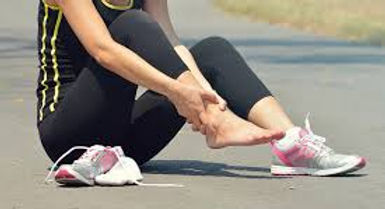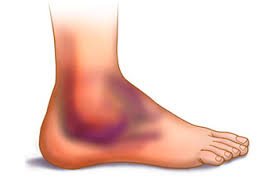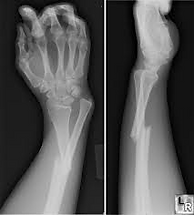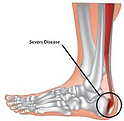
Know how to respond to injuries within a sporting context
ACUTE INJURIES
An acute injury is caused by a sudden trauma to the body e.g. a hard rugby tackle, a two footed tackle in football, being hit by the ball etc.
These injuries result in immediate pain, swelling and usually a loss of function.
CHRONIC INJURIES
A chronic injury is also known as an overuse injury and happens as a result of continuous stress on an area e.g. Achilles tendonitis, shin splints, tennis elbow etc.
These injuries tend to gradually develop over time.


Types, causes and treatment of acute injuries:
Sprains
A sprain occurs when one or more of your ligaments have been stretched, twisted or torn, usually as a result of excessive force being applied to a joint. Sprains are most likely to occur if you over-reach, change direction or speed suddenly, fall and land awkwardly or collide with an object or person.
Pain around the affected joint, being unable to use the joint normally or being unable to put weight on it, swelling, bruising and tenderness.
Minor sprains can usually be treated with rest, ice, compression and elevation. You should try to start moving a sprained joint as soon as it is not too painful to do so. Ordinary painkillers such as paracetamol can be used to help ease any pain. You can also use taping to treat some sprains
Strains
A strain occurs when muscle fibres stretch or tear. They usually occur when the muscle has been stretched beyond its limits or it has been forced to contract (shorten) too quickly.
Pain in the affected muscle, swelling, bruising, muscle spasms, loss of all or some of the function in the affected muscle, collection of blood under the skin causing a dark red like bruise
Can be treated with RICE, rest, ice, compression e.g. bandages to reduce swelling and elevation to prevent blood from pooling in the affected area and reduce swelling. Paracetamol.
Fracture
Open fractures and closed fractures are caused by trauma, most commonly from a direct blow, such as from a fall.
Signs of an open fracture: End of the bone is sticking through the skin, blood, swelling, pain.
Signs of a closed fracture: Pain, bruising, swelling, unable to move affected area.
Support the injury, try to keep it still by using a splint, call 999 or take to hospital. Patient will require an X ray followed by a cast, sling or possibly an operation depending on the type of fracture.
Abrasion (cut/graze)
A cut is a tear or opening in the skin which is caused by an external factor or from the skin wearing away. This could be from a fall, banging into something or being cut by something sharp.
Opening of the skin, blood, redness.
If the cut is infected there may also be signs of discharge or pus coming from the cut, fever, increased pain, swelling, or warmth in the affected area.
Clean the cut, cover with a dressing or plaster.
If the wound is infected injury you must see a doctor. To stop the infection from spreading, treatment most often consists of an antibiotic cream or ointment or a prescription for oral antibiotics.
Concussion
Concussion is the sudden but short-lived loss of mental function that occurs after a blow or other injury to the head.
Confusion, headache, dizziness, nausea , loss of balance, feeling stunned or dazed,
disturbances with vision, difficulties with memory.
Apply a cold compress to the injury to reduce swelling, take paracetamol to control pain –
get plenty of rest and avoid stressful situations where possible, make sure you have someone to stay with you for the first 48 hours after the injury – this is in case you experience more serious follow-up symptoms. If you do, you must go to hospital as soon as possible.
Blister
Blisters are most often caused by skin being damaged by friction or heat
Fluid collects under the damaged skin, cushioning the tissue underneath, most blisters are filled with a clear fluid (serum), but may be filled with blood (blood blisters) or pus if they become inflamed or infected
Most blisters heal naturally after three to seven days and don't require medical attention.
It's important to avoid bursting the blister, because this could lead to an infection or slow down the healing process.
If the blister does burst, don't peel off the dead skin. Instead, allow the fluid inside the blister to drain and cover the area with a dry, sterile dressing to protect it from infection until it heals.
Cramp
Overuse of a muscle, dehydration, muscle strain or simply holding a position for a prolonged period of time may result in a muscle cramp
Pain, tenderness and firmness of the muscle
The primary treatment of muscle cramps involves methods to relax the affected muscle. This typically involves stretching, massage, and heat application.
Contusion (bruise)
A bruise appears on the skin due to trauma. Examples of trauma are a cut or a blow to the area. The most common causes of bruising are: Bumps or any abnormal force applied to the body, falls, joint sprains, muscle strains and sporting injuries
A fresh bruise is often reddish. It will then turn blue or dark purple within a few hours, then yellow or green after a few days as it heals. A bruise is commonly tender and sometimes even painful for the first few days, but the pain usually goes away as the colour fades.
Most bruises will disappear within a few days or a week of injury without the need for any treatment but you can limit the internal bleeding by cooling the area with a cold compress or an ice pack wrapped in a towel.
Internal bruising cannot be seen on the surface of the skin but the person can suffer from pain and swelling. If this occurs you must seek further medical advice from the hospital.
Dislocation
A dislocation usually happens when the bones that are usually connected at a joint separate. This can be caused by a unexpected impact to the area, a blow or a fall.
Numbness or tingling at the joint or beyond it
Very painful, Limited movement, swollen or bruised, visibly out of place, discoloured, or misshapen.
Avoid moving the affected area.
You must go to A&E where you will be examined and have an X ray. Never try to pop the joint back into place yourself as this can cause further damage. The doctor will put the joint back into its socket. You may need a sling. Surgery is sometimes required if the tissues surrounding the joint are badly damaged.



Types, causes and treatment of chronic injuries:
Tendonitis
Tendonitis injuries usually happen during sports or activities that involve sudden, sharp movements, such as throwing or jumping, or after repeated overuse of the tendons, such as running.
Pain that gets worse when you move the affected area, stiffness, weakness and sometimes unable to move the affected area, swelling, a lump on the affected tendon.
Stop exercising, rest, pain killers and anti-inflammatory tablets, ice, physiotherapy, massage, heat packs and in some situations surgery.
Tennis Elbow
Tennis elbow is a condition that causes pain around the outside of the elbow. It often occurs after strenuous overuse of the muscles and tendons of the forearm, near the elbow joint.
Pain on the outside of the upper forearm, pain when lifting or bending your arm, pain when gripping small objects, pain and stiffness when extending the arm.
Rest and stop doing the activity that caused the problem, ice daily, painkillers, anti-inflammatory tablets, heat packs, physiotherapy, surgery may be required to remove the damaged part of the tendon as a last resort. Taping can also be used to help treat and rehabilitate the injury.
Golfers Elbow
Caused by overusing the muscles in the forearm that allow you to grip, rotate your arm, and flex your wrist. Repetitive flexing, gripping, or swinging can cause pulls or tiny tears in the tendons.
Pain and tenderness on the inner side of the elbow, stiffness, weakness and numbness or tingling in the fingers.
Rest, ice the affected area, anti-inflammatory tablets, an arm brace to support the arm, stretching and strengthening exercises, bandage or splint.
Shin Splints
Can be caused by running on hard surfaces, wearing poorly fitting trainers, have flat feet, have weak ankles or a tight Achilles tendon.
Dull ache in the shin area, pain that develops during exercise, tenderness or soreness along the inner side of the lower leg.
Rest and do not do the activity that caused the shin splints for two weeks, ice daily, heat packs painkillers and anti-inflammatory tablets, wear the correct running shoes, you may also require insoles in your shoes.
Injuries related to children

Severs Disease
-
Bone disorder. This is common in children who are physically active. During the growth spurt of early puberty, the heel bone sometimes grows faster than the leg muscles and tendons. This can cause the muscles and tendons to become very tight and overstretched, making the heel less flexible and putting pressure on the growth plate. Commonly results from physical activities and sports that involve running and jumping, especially those that take place on hard surfaces, such as track, basketball, soccer, and gymnastics. Common signs include swelling and pain in the heel and difficulty walking. Treatment will include rest, ice, compression and elevation (R.I.C.E) and to stretch regularly.

Osgood Schlatter's Disease
-
Osgood Schlatter’s disease is an inflammation of the bone, cartilage, and/or tendon at the top of the shinbone (tibia), where the tendon from the kneecap (patella) attaches. Teens increase their risk for Osgood Schlatter’s disease if they play sports involving running, twisting, and jumping, such as basketball, football, volleyball, soccer, tennis, figure skating, and gymnastics. Signs of the disease include pain that worsens with exercise and swelling in and around the knee. Treatment includes rest, application of heat and to stretch. Painkillers can also be taken.
How to respond to injuries and medical conditions in a sporting context:

S is for See. Did you see the injury take place?
SEE
St Antony's

A is for Ask the player what happened and how they feel. Check facial expressions, and posture (position either standing or lying down).
ASK
St Antony's

L is for Look at injured limbs for obvious signs of injury: bleeding, bruising, swelling, deformity. Take the player off if there are significant signs of injury.
LOOK
St Antony's

T is for Touch the injured site if the player will let you. Gently palpate to find source of pain. If you are unsure, don’t touch or move the limb until a qualified person can assess the player.
TOUCH
St Antony's

A is for Active movement: Can the player move the limb, with or without pain? If unable to move – take the player off.
ACTIVE
St Antony's

P is for Passive movement: If A applies, move the limb/joint to full extent and note reaction.
PASSIVE
St Antony's

S is for Strength: Can the player put their weight on it? Are they up and running or rather trying to “run-it-off”? Whatever the case, keep a close eye and take the player off if in doubt.
STRENGTH
St Antony's